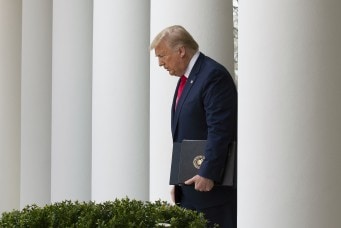Reinventing Governance for a Fragile and Complex New World
The COVID-19 crisis has laid bare the weaknesses of the international system; to fix the present and prepare for the future, we must pivot to a resilience paradigm.

Students wearing protective face masks practice social distancing at the courtyard of the flemish secondary school during its reopening amid the outbreak of the coronavirus disease (COVID-19), in Brussels, Belgium, May 15, 2020. Yves Herman/Reuters
Four months into the COVID-19 coronavirus crisis, we are trying to cope with the unspeakable loss of lives and the devastating impact on livelihoods. With so much uncertainty, “going back to normal”—if at all possible—is probably all that we can wish for.
For the future of governance, however, “going back to normal” is not only infeasible—it is undesirable.
As we consider how our world will change or what defines the “new normal”, some focus on the geostrategic implications of the pandemic: What does it mean for international order? Who will be “up” and who will be “down”? Others ponder about its impact on globalization; is this the end of globalization, or is it the beginning of a new chapter?
These are important questions that will profoundly affect our lives. No less important, however, is a more basic question: How did we get here in the first place? What went wrong?
Much has already been written about how we were caught completely off guard when the signs of an impending crisis were everywhere. This pandemic, we now know, wasn’t an improbable Black Swan. It was a catastrophe waiting to happen, and the question was never “if”, but “when”. The Severe Acute Respiratory Syndrome (SARS), Middle East Respiratory Syndrome (MERS), Avian flu, Swine flu, Zika, and Ebola outbreaks of the last few years can now—in retrospect—be viewed as mere rehearsals that were met with complacency. In fact, with all the alarms and warning signs, our failure to act preventively and decisively is an inexcusable human failure for which hundreds of thousands of people are now paying with their lives.
The failure of prevention before the pandemic struck was compounded by the slow, incoherent, and uncoordinated response once it did. In some rich countries, where the pandemic first hit, precious time was lost downplaying its impact, if not outright dismissing it out of hand. The fragility of even the most advanced healthcare systems, combined with the breakdown of critical supply chains and delays in enforcing lockdowns, undermined containment efforts. As a result, what started out as a public health problem has not only worsened, but has quickly triggered a full-blown economic crisis, the likes of which the world has not seen since the Great Depression of 1929.
The situation is destined to be much worse as the pandemic sweeps across lower-income countries. Most lack the resources and capacities to deal with a crisis of this magnitude. With weak healthcare systems, high population densities, limited access to clean water, and millions living hand-to-mouth in countries with weak to nonexistent social safety nets, the impact could be devastating. The collapse of commodity prices, soaring capital outflows, and an impending debt crisis will hit economies badly and plunge millions into poverty, with serious social, political, and security repercussions. And, the longer the crisis lasts, its impact will—akin to the aftermath of war—be development in reverse: the erosion of the hard-won gains of decades of economic and human development.
But for all the avoidable devastation and suffering they have caused, the missteps of the last four months are hardly the reason we are here today. We are here today because the world’s structural fragility has reached a tipping point and the moment of reckoning has finally arrived. Our world is not about to change; it has already been changing in plain sight, for a long time and in incredibly significant ways.
While powering human progress, the increasing interdependence of societies and the tightly-knit global system have also given rise to various forms of vulnerability. In its steady march to lift millions of people out of poverty, globalization has also destroyed or dislocated a similar number of jobs, exacerbated inequality, and given rise to populist and nationalist movements currently reshaping politics around the world. While it has powered innovation and mobility, global connectivity has also accelerated the spread of extremist ideas and infectious diseases.
From climate change to the rising conflict–terrorism–crime nexus to the perils of cyberattacks, the list of globalization’s unintended consequences is a long and dangerous one. The systemic risks they pose are of a qualitatively different nature to what the world has faced before. They are complex, interconnected, and contagious and exert pressures that build up over an extended period, but once released wreak havoc on the entire system, not merely a part of it.
What has unfortunately not been changing—at least not at the same speed and depth—is our response to these pressures. Many individual nations failed to find novel solutions to the structural vulnerabilities of ailing societies or employ innovative means to break through political gridlocks and zero-sum politics. As an international community, we failed to act on the recognition that our institutions have become outdated, and that our tools of managing crises have become overstretched and unsustainably costly.
With broken politics and inadequate institutions, muddling through has become our default reflex. We managed crises rather than prevented them. We won wars, but seldom peace. We simplified the complexity of the world rather than embraced it. We adapted problems to our tools and capacities, rather than the other way around. Life went on, or so we thought, until this pandemic laid bare the long crisis of global governance.
Despite similarities with earlier systemic shocks such as the Great Recession, this crisis is uniquely different. It is not only hitting every country in the world, but also each of us personally. It is forcing us to take the idea of failure more seriously, obliging us to consider not only the likelihood of disaster, often leading to faulty cost-benefit analysis, but also the intensity of potential adverse consequences and our exposure and vulnerability. Its novelty and complexity inhibit extrapolation from the past to the future. In other words, there is no last war to be fought.
Long-term Strategy Needed
While it is far too early to definitively draw lessons from the current pandemic, the implications for the future of governance are as huge as they are clear. For the near future, societies, governments, and international institutions will need to focus on containment, mitigation, and recovery. And to succeed, these efforts should be part of a longer-term strategy for rebuilding. With a similarly devastating systemic crisis on the horizon, like climate change, the goal cannot be to restore the status quo, but rather to lay the foundations of a new equilibrium. In the words of Henry Kissinger, “addressing the necessities of the moment must ultimately be coupled with a global collaborative vision and program”—one that can sustain the benefits of globalization while mitigating the worst of its unintended consequences.
The task at hand of reinventing governance for a fragile and complex new world could not be more daunting. For many countries, this would require a renewal of the social contract, including redefining and reprioritizing the central questions of politics. In addition to enhancing preparedness to shocks, it would entail rethinking approaches to contending with the root causes of problems and the structural vulnerabilities ailing societies. It would also necessitate major departures from mainstream policies on a wide range of issues, from healthcare to inequality. For the future of international cooperation, it would demand deep and far-reaching institutional reform. It would also necessitate a rethink of the current configuration of the global governance architecture and a rekindling of its tools.
The last few years have seen a subtle, yet growing, global convergence over the need to shift to a resilience paradigm and agenda. Resilience is defined as the ability of a community or country to withstand, cope with, adapt to, and recover from stresses and shocks without undermining long-term peace and development. As a foundation for action, it has already informed multiple global frameworks, including the 2030 Agenda for Sustainable Development, the 2016 Sustaining Peace Resolutions, the Sendai Framework for Disaster Risk Reduction, and the Paris Climate Agreement. Together, these frameworks represent the closest that we have right now to a blueprint for shaping the post-pandemic world.
To accelerate the paradigm shift to resilience, urgent action is needed on both the policy and institutional levels. On the policy level, the current crisis makes clear that embracing a resilience paradigm can’t only be based on stand-alone risk assessments, which often fail to translate into concrete action, but should also inform the development and implementation of policies. While societies will never be prepared for all risks, risk-informed policies and regulation would enable decision makers to anticipate, prepare for, and respond to crises, and to adapt to change while retaining states’ structure and function. Risk-informed budgets would similarly allow them to manage the difficult tradeoffs between efficiency and resilience in the short, medium, and long term, including prioritizing and accelerating critical investments.
A shift to risk-informed national policies would also bring prevention to the fore of national and international efforts, both as an end in and of itself, and as an enabler of sustainable development and peace. As highlighted by Pathways for Peace, the first joint report of the United Nations (UN) and the World Bank, prevention is not only cost efficient for averting the devastating impact of conflict; it also works. The current pandemic proves that in an era of global systemic fragility, there is a growing list of risks that are either intolerable or unacceptable, for which prevention—not management—is the only policy option. A climate crisis of the magnitude and scale we are warned of is an example.
Pivoting to a resilience paradigm would be incomplete without embracing complexity as the defining feature of fragility and systemic risks. Single-threat risk analysis and single-issue sensitivity approaches, such as conflict sensitivity, has indeed allowed us to gain a better understanding of the two-way interaction between our actions and the contexts in which we operate. They fail, however, to account for the interactions and non-linear dynamics between various risks. Embracing complexity in our analytical, planning, and programming tools would significantly enhance our ability to understand not only the interdependencies between various parts of the system, but also the impact of our actions on the totality of the system, not just isolated parts of it.
Complementing these changes is the need to overcome fragmentation of policy formulation and implementation on the institutional level. During the 2016 World Humanitarian Summit, the UN Secretary-General and the heads of multiple UN agencies, with the endorsement of the World Bank and the International Organization for Migration, signed a “Commitment to Action” document committing their organizations to a “new way of working” in crisis situations through a humanitarian–development–peace nexus approach. This was a step in the correct direction. It allowed for a shared conception of vulnerabilities and risks and enhanced interoperability between various actors. Indeed, recent assessments showcase good practices and future opportunities for using shared analysis, joined up planning and programming, and pooled financing modalities in pursuit of collective outcomes.
Beyond interoperability, however, pivoting to a resilience paradigm would be impossible if not underpinned by deep institutional reform and a reconfiguration of the global governance architecture. The current crisis has amplified the sharp contrast between the complexity of today’s systemic risks and the organizational logic of the postwar governance architecture governing them. While the former is turbocharged by hyper-connectivity and nonlinear dynamics, the latter continues to emphasize bureaucratic chains of command and specialization. As a result, those siloed hierarchical designs, while possibly valuable in managing complicated systems, are utterly unfit for the purpose of governing complexity and the qualitatively different set of governance challenges it brings to the fore.
While there is certainly room for enhancing the implementation of existing global agreements and frameworks and for creating new institutions to tackle novel issues, the pressing question that leaders must contend with in the medium and long term is whether the current configuration of governance architectures can be repurposed to address today’s systemic risks. The ongoing reform efforts at international and regional institutions, including the UN and the African Union, should therefore be regarded as opportunities for strategic reflection and organizational renewal rather than mere redrawings of departmental fault lines.
The outcome of this crisis is far from preordained. A blueprint for managing our fragile and complex world has been taking shape for years, anchored in a resilience paradigm that acknowledges the complexity of today’s world and the qualitatively different nature of its systemic risks. Accelerating this paradigm shift and advancing the institutional reforms it requires is the primary task of the post-pandemic leadership.
Ashraf Swelam is director general of the Cairo International Center for Conflict Resolution, Peacekeeping and Peacebuilding (CCCPA). He is currently the co-chairman of the Integrated Disarmament, Demobilization and Reintegration Training Group, and a former president of the International Association of Peacekeeping Training Centers and the African Peace Support Trainers Association. His articles appeared in the Financial Times, Yale Journal for International Affairs, Global Policy Journal, Die Zeit, and Süddeutsche Zeitung, among others.
Read More



